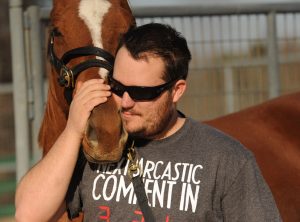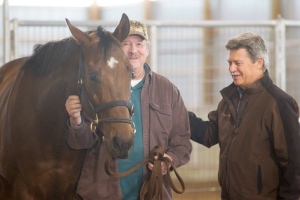By Ken Olsen
(Copyright 2016, All Rights Reserved)
Rob Saavedra refused to acknowledge he had PTSD. The Air Force veteran and sheriff’s deputy worried the people around him – particularly coworkers – would consider him weak. And when he finally sought help from two different PTSD programs, he got no relief from the nightmares, panic attacks and exhaustive hypervigilance.
Seven minutes with a horse changed everything.
“It’s just amazing how all of a sudden you start meshing with the animal,” Saavedra says as he tries to sort out how he just persuaded a hot-blooded thousand-pound thoroughbred to trust him. “They melt into you. I wish I would have come a long time ago.”
Saratoga WarHorse founder Bob Nevins calls this epiphany “the sacred moment,” often marked by a veteran burying his face in the horse’s neck and sobbing. “The veteran is relieving years of anguish and nightmares,” explains Nevins, a decorated Vietnam medevac pilot who knows both combat trauma and the power of the horse-human connection firsthand. “We just let it unfold.”
More than 400 veterans have had similar experiences at Saratoga WarHorse since Nevins quit his day job and exhausted his retirement savings to launch the program in 2011. The reward comes in emails and phone calls from grateful veterans who report sleeping for the first time in years.
“The soldier’s heart gets hardened in the war experience,” wrote Denny Sedlack, a 2015 graduate of Saratoga WarHorse who served as a Navy corpsman in Vietnam followed by 15 years in the Air Force. “The horse-human connection bridges the difference between the war world and the civilian world. And the horse-human connection tempers the pain of killing (and) being killed.”
Nevins also hears from spouses and therapists who are surprised by the dramatic change in veterans who attend the program. “They call me and ask, ‘What did you do with this guy?’” Nevins says. The most potent endorsements come from veterans like Clay Stanhope and Mary Kay McCollum, who saw suicide as their only remaining option.
“I owe my life to Bob and his crew,” says Stanhope, an Army veteran who served in Afghanistan and Iraq and lost everything to divorce soon after returning home to Alabama in 2012. “The VA wouldn’t touch me. Nobody would help me. I was completely lost.”
McCollum, a Navy veteran and military sexual assault survivor, planned to jump off the Monroe Street Bridge in her hometown of Spokane, Wash., after years of traditional therapy failed to touch her night terrors. “You get stuck in the trauma and there’s nothing you can do to get out of it,” McCollum says. “There’s no amount of talking, cognitive therapy and drugs that can help.”
Unconditional acknowledgement
A map on a wall of Saratoga WarHorse’s modest office, just off a quiet, tree-lined street in Saratoga Springs, N.Y., tracks the places in the United States with the highest veteran suicide rates. The epidemic prompted Nevins to start Saratoga WarHorse after he researched the horse-human connection and tried it for himself . “Every bit of anxiety I had washed away,” Nevins says. “That’s why I started thinking this would work with other veterans.”
He recruited Melody Squier, a noted Vermont equine expert, to help him create a program in which veterans could have the same experience. Then he quit his job as an airline captain and emptied his retirement savings to get Saratoga WarHorse off the ground. “It was my dream job,” Nevins says of flying, “But it wasn’t as fulfilling as this.”
Saratoga WarHorse isn’t providing mental health treatment, counseling or therapeutic riding. “These veterans are so sick of people talking at them and writing them prescriptions,” Nevins says. “I don’t get into their trauma. I don’t give advice. I create an opportunity for them to have this experience.”
The experience is all about resetting the emotional circuit breaker. “Anytime a human being has a traumatic event in their life – from sexual assault to seeing your buddy blown up in combat – their emotional circuit breaker pops,” Nevins says “It’s like tripping the electrical circuit breaker in your house. The lights go out. You are walking around in the dark.”
Likewise, veterans with PTSD can’t sleep, can’t cope with their nightmares, can’t fully and functionally re-engage with civilian life. It takes a powerful positive experience, in this case bonding with a horse, to reset their emotional circuit breaker.
Horses have two biological attributes that make them the ideal animal to help , says Tim Hayes, Air Force veteran, horse trainer and author of Riding Home: The Power of Horses to Heal. Horses, like veterans with PTSD, are hypervigilant. Because they are also highly intuitive, horses sense that similarity, which makes it easier for them to bond with troubled former servicemembers.
In addition, horses have highly developed social skills – including tolerance, acceptance, forgiveness and compassion – that are critical to their ability to live in a herd. “If a horse gets with someone who is wounded, compassion immediately kicks in,” Hayes says. “That feeling that veterans get from a horse is unconditional acknowledgement. It’s a mental, emotional and physical shift for them.”
That shift enables veterans to open up to spouses and therapists and start rebuilding their lives. “The horse isn’t the end of the healing process,” says Hayes, who has attended Saratoga WarHorse. “It’s the kick starter.”
Legion support
Nevins, a member of American Legion Adirondak Post 70 in Saratoga Springs, makes it easy to attend Saratoga WarHorse. The program pays all expenses, including airfare, so there’s no VA approval process, insurance paperwork or financial barriers. Nevins receives support from community and fraternal groups in both New York and South Carolina, where a satellite operation opened with the help of horsewoman Anne Campbell. This includes Knights of Columbus, Rotary and the Elks as well as donors from the thoroughbred racing community such as Bob Baffert – trainer of 2015 Triple Crown winner American Pharaoh – and his wife Jill.
Joseph E. Zaloga American Legion Post 1520 in Albany, N.Y., has raised money for Saratoga WarHorse. American Legion Whiteman Hull Snyder Post 1360 in Cherry Valley, N.Y., has donated half of the proceeds from its Veterans Day weekend 5K run to the program since Nevins sparked the interest of former post commander Alan Grover.
“Twenty active members of our post raised $10,000 for Saratoga WarHorse over four years, which shows what can be done by a dedicated group and great local businesses for a great cause,” Post Commander Dave Lamouret says. When Grover died in 2015, his family asked for donations in his memory to the program. “Alan’s family loved Saratoga WarHorse, loved that our race was raising money for a great cause,” Lamouret says. “Last year, all of Alan’s family came to help coordinate our 5K race and a couple of them ran the race.”
Word of mouth
Many of the veterans who come to Saratoga WarHorse have never touched a horse. Some are terrified of the imposing animals. Most are skeptical the program will help them.
“I would never have imagined this would have worked,” says Rich Keiser, past Commander of the American Legion Department of New York, who came to Saratoga WarHorse in early June. “I have PTSD and I got more out of WarHorse than I have my therapy at the VA and my group therapy. I hope a lot more veterans will try it,” adds Keiser, who was wounded on the infamous Hamburger Hill during his tour with the 101st Airborne in Vietnam in 1969.
Participants are often referred by veterans who have been to Saratoga WarHorse or by family members who persuade them to give it a try. A growing number of counselors are referring veterans as word of the program’s success spreads.
The application process is simple: A telephone conversation with Nevins. “I don’t want anything between me and the veteran,” he says, even though this sometimes means midnight phone calls. Nevins can quickly assess if a veteran is in trouble. “When a kid tells me he hasn’t slept in 10 years, I don’t have to ask him any more questions,” Nevins says. “And they appreciate that. They don’t want to talk about it.”
Nevins and WarHorse Program Coordinator Janelle Schmidt also don’t describe the horse-human interaction in great detail to veteran who inquire about the program. They just try to make it feel safe for veterans to come and give it a try.
Saratoga WarHorse sessions are small, typically involving six veterans. Participants run the gamut from the Korean War era to the wars in Iraq and Afghanistan. About 30 percent are military sexual trauma survivors.
The first event is a low-key get-acquainted dinner that steers clear of war stories. The next morning the veterans head to a leased farm about a half-hour from Saratoga Springs. They learn the fundamentals of horse behavior – and winning the trust of a horse – from Squier. That’s key because, “As a prey animal, horses don’t immediately like you or accept you like most dog will,” Hayes says. “Before a horse accepts you, he has to trust you.”
By late afternoon, Squier selects a retired racing thoroughbred for each veteran. One by one, they lead their horse into the round pen for the critical encounter. And when horse and veteran connect, there’s a transformative moment that often moves the veteran and Saratoga WarHorse staff to tears. It’s difficult for veterans to articulate precisely what transpires. But they are all adamant about the life-changing power of the connection – and a resulting sense of relief they haven’t felt in years, if not decades.
“Most of the time when I talk about this, I lose it,” says 83-year-old Norman Seider, a Korean-era Army veteran. “There were several heavy moments with the horse, a bonding, then stuff began to pour out of me – not verbally – but it came tumbling out of my head. The anger and the stress just sort of flowed out.”
Universal connection
That encounter between human and horse is healing no matter the age of the veteran nor the reason for their PTSD. “There’s no difference with a 24-year-old veteran and a 68-year-old veteran. They have the same nightmares and the same issues,” Nevins says. “There’s no difference between military sexual trauma and losing your buddy on the battlefield. The trauma and the affect are the same. We give them the same experience, because the experience creates the change.”
Participants are enthusiastic about that change. McCollum found the strength to leave her abusive husband after 28 years and plans to start a blog to help other female veterans, particularly those who have suffered military sexual assault.
Clay Stanhope went from living in a homeless shelter and attempting suicide to a successful job as a long haul trucker. He’s gotten service connected with the VA since Saratoga WarHorse, a success he credits to Nevins and a fellow Alabama veteran – Glenn Knight – who recommended Nevins’ program.
Knight still isn’t sure how an encounter with a horse was powerful enough to penetrate the emotional walls he built in the wake of his tour as a crew chief and helicopter door gunner in Vietnam. “That horse told me, in a way I don’t understand, ‘It’s OK – you can trust people. You can come out of your foxhole.’” This from man who was consuming his seventh large glass of bourbon the night he first talked to Nevins on the telephone. “I’ve found new life,” Knight says. “I found faith in the church. I sing in the choir. It’s an experience I’ll never forget.”
For Nevins, the payoff comes from veterans spreading the word about Saratoga WarHorse. “I know when a veteran shares this with another veteran who hasn’t been here that they get the same satisfaction from touching someone’s life.”
A version of this story originally appeared in the September 2016 issue of The American Legion Magazine.


